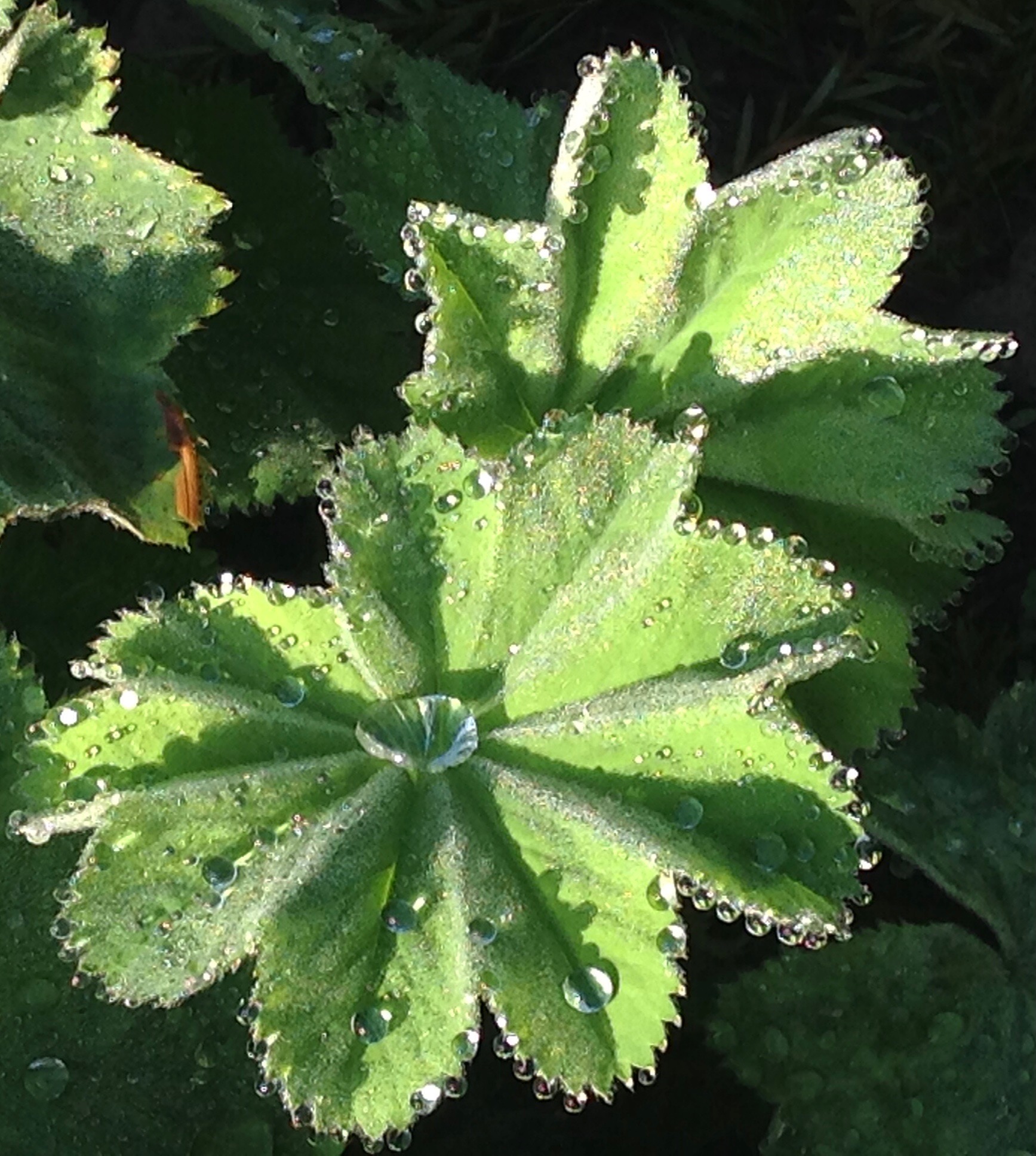Alison Agnew is the new contributor of the Roseland Online Gardening Feature. She is a retired Biology lecturer and amateur but long time gardener and designer. She has a particular interest in the technical, aesthetic and health aspects of gardening. This month she explains why she is ‘euphoric about Euphorbias’.
“I have a bit of a thing about green flowers”.
Is this just perverse? Colourful flowers are the glory of a garden and the many greens of various foliage should be enough of a foil for them. But – somehow I’ve accumulated over 20 Euphorbias – most of them green flowered and many really important to the spring garden. They form good blocks of acid green that let the more fragile flowers of spring really zing.
Many Euphorbias are evergreen so they also provide good winter structure.
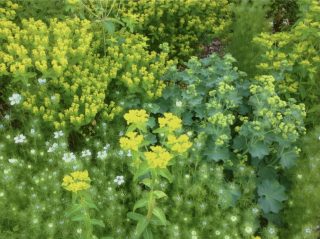
No garden should be without the easy Euphorbia oblongata – it flowers almost all the year round if cut back regularly. It’s an evergreen, rather woody perennial — growing to 40cm that self seeds. It grows in full sun or full shade and in any soil so is a good groundcover under shrubs and trees but a happy contrast to sunny perennial plantings too.
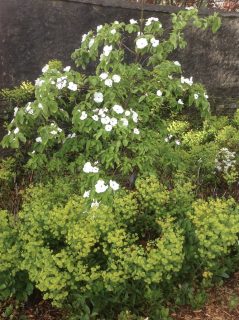
E. robbiae is also great under trees – tough whorls of dark green leaves to 30cm. The heads of lime green flowers from late February look wonderful with snowdrops and white daffodils and persist long enough to sharpen up the blues of Bluebells, Honesty and Forget-me-nots.
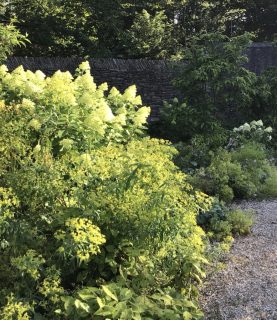
E.margalidiana is much larger — a light-weight shrub with narrow evergreen leaves and frothy sprays of lime flowers almost year round. E.characias wulfennii with glaucous evergreen leaves and shocking lime flowers lasts from February to April. Both of these work well as spot plants among other shrubs and both have the generosity to seed themselves about — though not too prolifically.
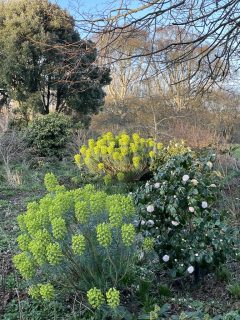
The wonderful shrubby euphorbias, E.mellifera and E.stygiana flower in later spring. Both evergreen, E.mellifera is a fresh green with brown flowers and will grow over 2m if allowed to.
E.stygiana is a great favourite with me, growing to 1.5m high but 5m wide in sun or shade and hardier than
E.mellifera despite looking much more exotic. It has strong glossy green leaves in whorls and always looks tidy. If stressed by cold or drought some of the leaves will turn bright red. The lime green flowers are held in flattish sprays. Both species have honey-scented flowers, quite soporific on a calm, warm day.
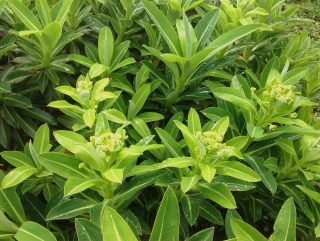
Then there are the large herbaceous species that I use in the borders to make the summer flowers sing — E.sikkimensis, E.schillingii, E.palustris and E.valdevillosocarpa. All grow from the ground to 1.20m very year and have long flowering times. E.valdevillosocarpa has the strange behaviour of starting to flower when only 20cm above ground and growing upwards while flowering all the while.
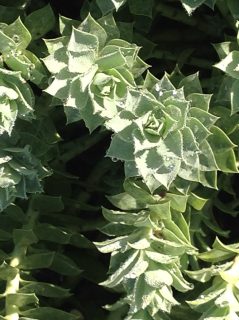
I also love the semi-succulent and sub-shrubby Euphorbias, good for dry banks, walls and rock gardens. E. myrsinites has spirally-arranged, evergreen blue-green leaves that snake across the ground and contrast with the acid green flowers.
Green-flowered Umbels
Several of the Umbelliferae family (now, less helpfully, called Apiaceae) also have lovely green flowers.
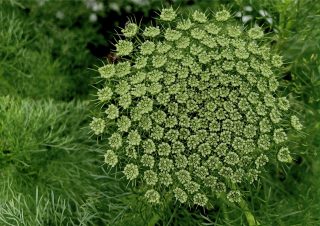
The annual Ammi visnaga Green Mist grows to about a metre and has lovely frothy foliage and perfect symmetrical umbels in soft green.
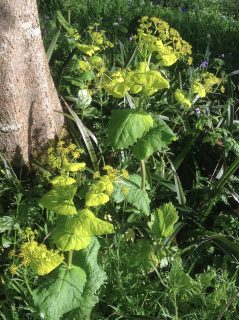
Smyrnium perfoliatum is a biannual with glowing lime bracts around the light umbels. They self seed under trees, light up the deepest shade, and contrast vividly with bluebells.
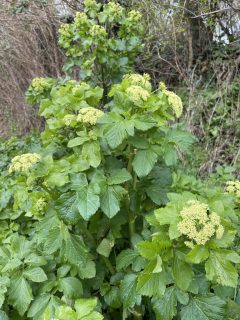
Smyrnium olusatrum is the familiar Alexanders – the first of the umbels to flower in our coastal hedgerows. It shoots up in February to flower in March-April with domes of nectar-rich green flowers so very valuable to early emerging insects. You can eat the young shoots if you really want to — they taste somewhere between celery and parsley and were valued as a cure for scurvy. I prefer to eat oranges, but welcome in wild Alexanders to blend the edges of my garden into the countryside.
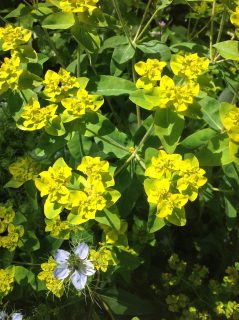
I value two Bupleurums but I’m ignorant of others that may be just as good. Bupleurum rotundifolium is an annual that self-seeds happily in open ground. It has curious leaves that encircle the stems and pretty clusters of flowers with largish bracts.
Bupleurum fruticosum is a shrub from dry mediterranean hillsides and suited to coastal planting in Cornwall. It is an elegant plant with glaucous foliage, purplish stems and is covered in greenish yellow umbels and persistent green seed heads all summer long. It will grow in a large dome to 2m but is best cut back in spring to keep it from falling apart.
And yet more greens:
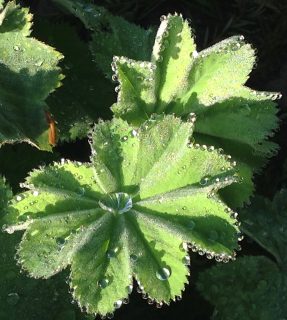
Everyone’s favourite green-flowered perennial is Alchemilla mollis. It will happily rummage around at the foot of shrubs and roses. Its felty leaves are edged with beads of dew in the morning and its frothy masses of tiny lime flowers smell of mixed spice in the heat of the day.
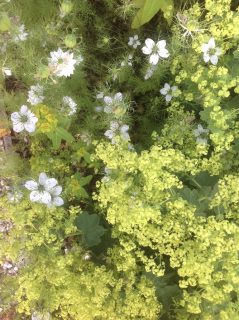

Trochodendron aralioides or the Wheel Tree is a shrub or tree that, unrestrained, will grow to 20m. It is the lone extant species of the genus and only has one cousin in the family so you won’t have seen anything like it. It looks very exotic but is native to upland forests in Japan, Korea and Taiwan, and is fully hardy in most of the UK. The evergreen leaves are carried in whorls and the flowers emerge as a cone of green spoked wheels out of bright red buds. It flowers at the time of Rhododendrons and Azaleas and can’t compete with their brilliance but is restfully, quietly beautiful at all times.
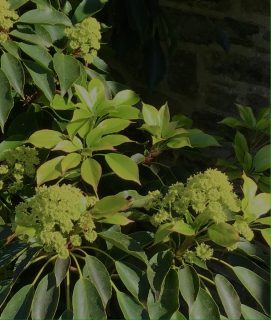
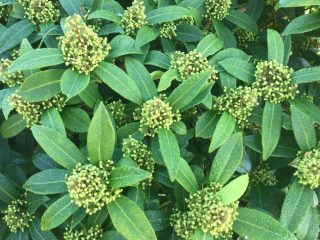
Skimmia x confusa Kew Green is a low evergreen shrub with dark green leaves that teams up well as an underplanting with Camellias and Rhododendrons. It has rather solid inflorescences of bubbly pale green flowers in March – April.
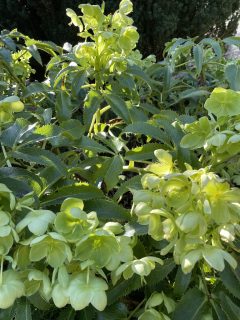
And then — there are more: Echinacea Green Jewel, and several green-flowered hellebores, and species of Paris, and even green-flowered tulips and, I am sure, many many more that I am unaware of.

